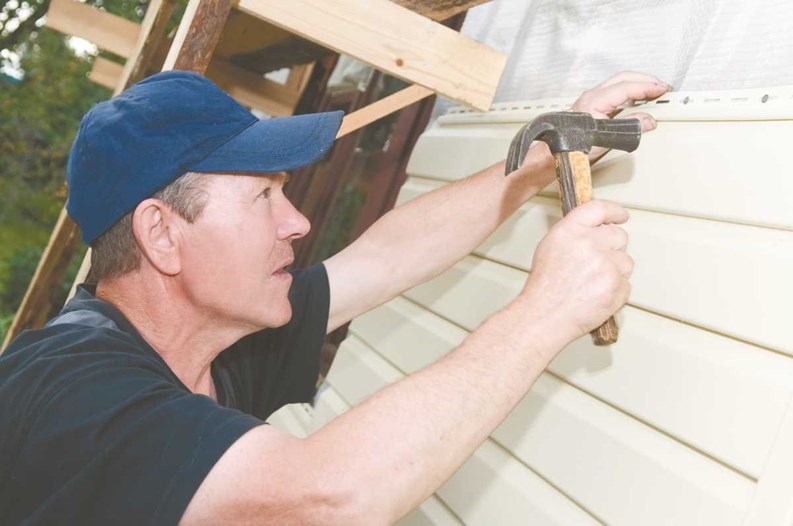After years of wear and tear from the elements—or just the impact of a single catastrophic event like Superstorm Sandy this past fall—the siding on the exterior of a condo, co-op or townhome can start to look a bit under the weather.
Wind, rain, fluctuating temperatures, direct sunlight, salt water, improper maintenance or even poor installation all can contribute to the deterioration of siding. While construction technology has come a long way since the days of plain wooden planks covering homes, prudent board members and other residents will think about the overall care of siding, as well as the proper installation and life expectancies of the varying types available. Having a board with little bit of knowledge in this area can lead to large cash savings in the long run for a building or HOA community. And the savings in lack of hassles, project errors or unnecessary delays on a siding or decking job gone awry can be of inestimable value as well.
Choosing Siding
When choosing a siding type, a material that may look nice at first glance could actually be a poor match for your building, depending on the weather conditions in your area and other factors. By doing some homework ahead of time, a savvy board can have a good idea of what they're looking for and what their building community needs; they also understand the performance expectations of different products and can choose the best type of material for their building or buildings.
The differences between wood, vinyl, and other composite siding materials are pretty distinct.
Vinyl siding is the least labor-intensive option, requiring minimal maintenance—often just an annual power washing. It is billed as the longest lasting of all types of siding, with some manufacturers giving a 50-year warranty on the product. Practically speaking, vinyl siding should have a usable life of about 30 years or so, according to most contractors.
Composites such as fiber cement are quite durable as well, and with proper maintenance can last 30 to 50 years, but they can be pricey. Hardie Plank, a cement fiber siding material, needs to be caulked every two years, power-washed annually, and eventually will need to be painted and then re-painted regularly thereafter.
Wood has a high maintenance cost, but it does have the softer, natural look that many people want, albeit a look that comes without much of a warranty. Even so, say the pros, with proper repair, maintenance, and sealing every five years, cedar shake siding could last as much as a century. Treated wood decking can last 10 to 15 years or more, but cedar or maple decking will last up to 50 years if it is well cared for. To keep that natural appearance, the owners will have to ensure that the siding gets the right care. Most wood siding must be caulked every two years, power-washed annually, and regularly painted to prevent rotting.
Aesthetics vs. Practicality
Regardless of the type of material, age and weather will dictate when to replace it. But to some people, weathering of the material could be little more than a cosmetic consideration, since weathered siding sometimes continues to perform pretty well even when it doesn’t look great. For others, ugly siding must go, pronto. How speedily that happens depends mostly upon the durability of the siding, and how well it has been cared for since its initial installation.
“If you’re in a region with a more severe climate, you want to invest in higher quality types of siding,” says Ross Marzarella, vice president and chief operating officer of All Country Exteriors, located in Lakewood. “The natural and wood products last the longest, but can require more maintenance. The more severe the weather environment is, the more you want to go towards the composite materials.”
Overall environmental conditions can be major consideration when choosing the right type of siding for a building. Knowing the capabilities of the products is an important part of the process. Trex, a composite material type of decking, is probably the wrong type of decking for a place where there is a lot of foliage around, because fallen leaves can stain this type of deck.
The main difference between wood and things made to look like wood such as composites are that composite products have many of the characteristics of wood but don’t look as good, Marzarella says. “Like vinyl, composite products last, but don’t look as good,” Marzarella says. “All types of siding can last a lifetime—it’s just a matter of what condition you want them to be in at the end of your life.”
To make the best choice of material, it helps to follow the advice of the seasoned pros, who can guide a buyer to the right product. “We try to recommend what’s best for the consumer,” says Arnold Roeland, owner of Roeland Home Improvers in Rockaway.
Careful Installation, Consistent Maintenance
For those who want to do it right, picking the best contractor for a siding job will require some work. But the effort spent will be small change compared to the energy cost savings that having the correct building envelope will bring residents. Siding is an integral part of a building’s exterior envelope, and having the right siding that is insulated, properly installed and durable, could bring long-term savings in a building’s energy costs.
Knowing how to maintain siding is not so apparent, though, since the type of required maintenance varies from siding material to material. But for those who see the indicators, siding that needs repair or replacement can be pretty obvious.
Usually, weather and aging are both factors in deciding when to replace vinyl siding, says Roeland.
“Time really doesn’t matter unless the siding is aging poorly,” Roeland says, adding that other signs shouldn’t be ignored. “Chalking, where the color rubs off on your hand, or loose seams and water infiltration are signs that replacement should be done soon.”
Obvious signs that vinyl siding replacement should happen in the near future include indications that the siding is starting to buckle, become loose, or warp. Damaged pieces of siding can be another reason to replace it, says Brian Bolger, co-owner of Magnolia Development in Kenvil.
Some defects that could end in replacement are not as apparent to the untrained eye. Water infiltration into the building or behind the siding, unexplainable leaks in the siding (specifically around windows), and any seams coming open, or visible cracks in the siding, are indications that replacement might be needed. Failing to take care of leaks, especially those water leaks where the extent of the destruction isn’t clear, might ultimately result in damage to the building’s structure.
Aging of certain types of materials should be expected. Expansion and contraction due to the weather changes tends to damage vinyl siding over time. Telltale signs that replacement may be imminent for composite siding materials are clear when the product’s color is fading, and when the product is chipped or broken. Obviously, caring for siding properly will extend its lifetime and conversely, failing to do so will shorten its life.
A qualified contractor can guide a board through all of this, but board members will have to do some work to find the right company if they haven’t worked with such a contractor before. A board should get referrals of contractors capable of performing the work from the building’s property management company, as well as from the engineer and other professional sources. And companies should be interviewed and vetted before they are chosen for a project.
Contractor Licensing
There is no siding-specific licensing required by the state of New Jersey for a contractor to be able to install these materials. The state does require general contractors to be licensed as contractors, and any company that might be hired by a community should be both licensed and properly insured. Even so, this lack of specific state certification leaves a lot of wiggle room for contractors to claim to have expertise that they don’t really have, since there is no government-regulated designation for contractors installing siding in New Jersey. Check with other buildings and communities who have used this particular contractor, and verify that the firm does good work, before you hire them.
Fencing, Decking & Checking
Given the fact that a siding job can cost tens of thousands of dollars or much more, boards should keep an eye on the bottom line of such a project. This oversight begins with having the building’s engineer create specifications for the job, and then having the engineer help the board to vet and hire the best contractor. Engineers vary in their real-world technical knowledge of different construction methods, though, and hiring one is not in itself a fail-safe route to a successful siding or decking installation project.
When a community is undertaking a siding job or any other major construction project, an extra pair of trained eyes could be necessary. Oversight is the best preventative measure to failure. One way to ensure that the quality of workmanship on such a job is what it should be is to hire another siding expert to spot-check the work as it progresses, Roeland says. Ideally, a Vinyl Siding Institute (VSI)-certified contractor should keep an eye on such a job. Too many communities don’t do this, he says.
“I see a lot of jobs that are actually being installed against the manufacturer’s specifications, because nobody involved understands how to do it,” Roeland says.
Board members and other residents alike should make sure there is an appropriate maintenance schedule for the co-op, condominium or townhouse community. Who is responsible for making certain that the maintenance checks and proper maintenance work is being done on the building’s exterior? And who is making sure that that person—be they the super, property manager or another—is doing the job?
Wood decking, if properly cared for, could last 25 years, Roeland says. “It’s all relative to the care the decking is given during the time that it is installed… A pressure treated wood deck should be re-sealed every five years,” he says. “If you don’t paint wood or repair it every five years, it’ll be the most expensive product you could use.”
Perhaps the most important part of any fencing, decking or siding project is the installation itself. If improperly installed, siding or decking might not see half of its expected life. For decking and fences, the job starts with the right foundation.
Both fences and decks require that posts be set in concrete footers, for durability and permanency. As with siding jobs, such projects have varying warranties on them (depending upon product and contractor), and often, financing plans are available. Generally speaking, these building materials all are guaranteed for manufacturer’s defects. Warranties for projects usually are spelled out in the contract for the work.
Depending upon the product, contractors can be certified in the specific installation of the brand, through its manufacturer. Using such a contractor will give the buyer added protection, if anything goes wrong, since the manufacturer will stand behind the installation work.
Jonathan Barnes is a freelance writer and regular contributor to The New Jersey Cooperator.







Comments
Leave a Comment